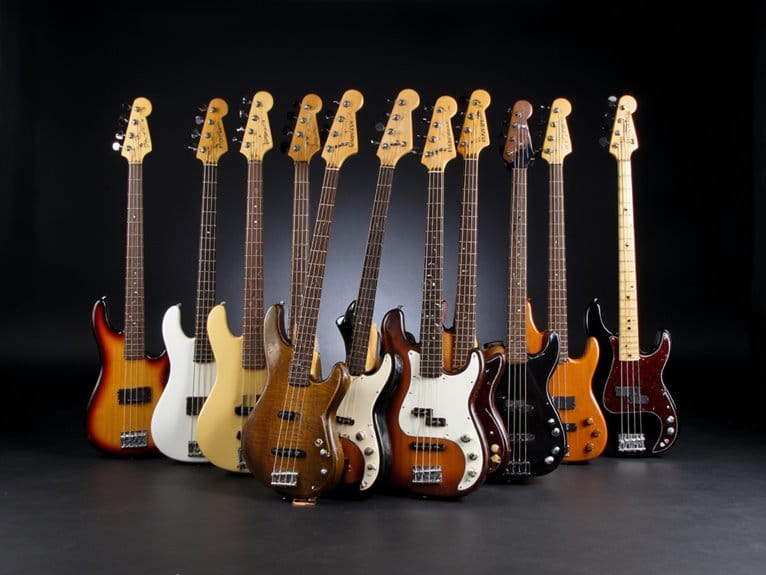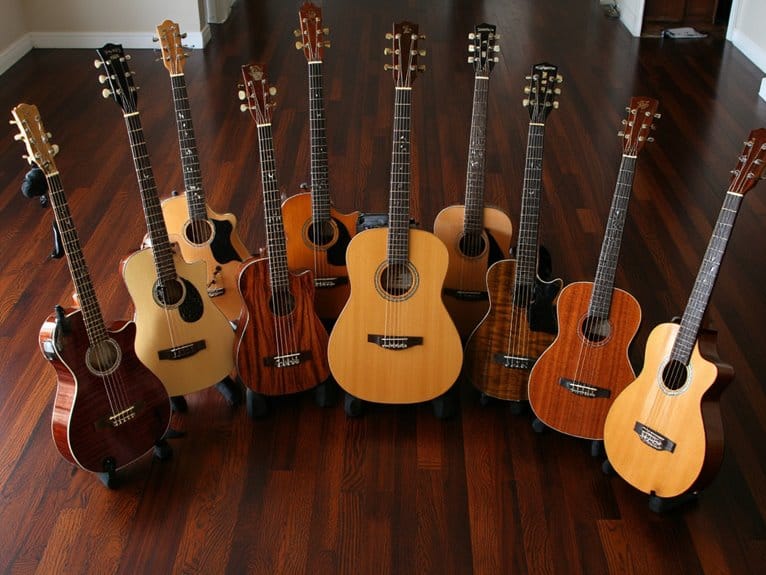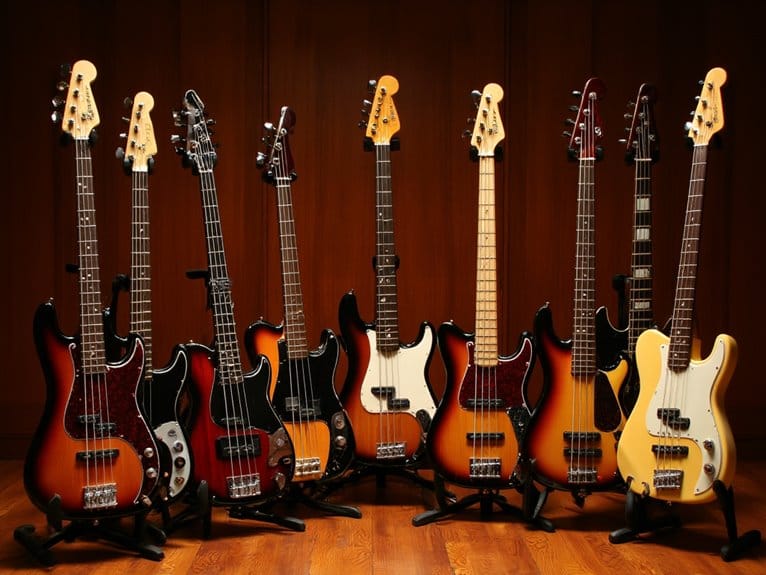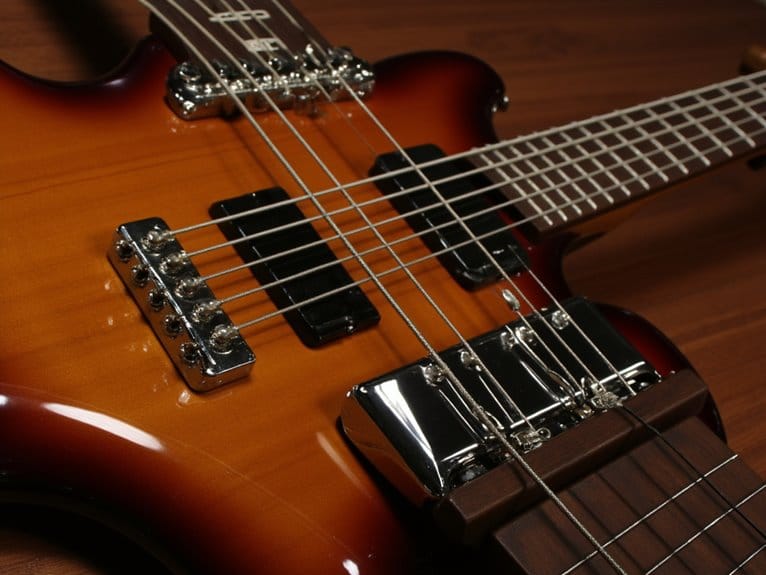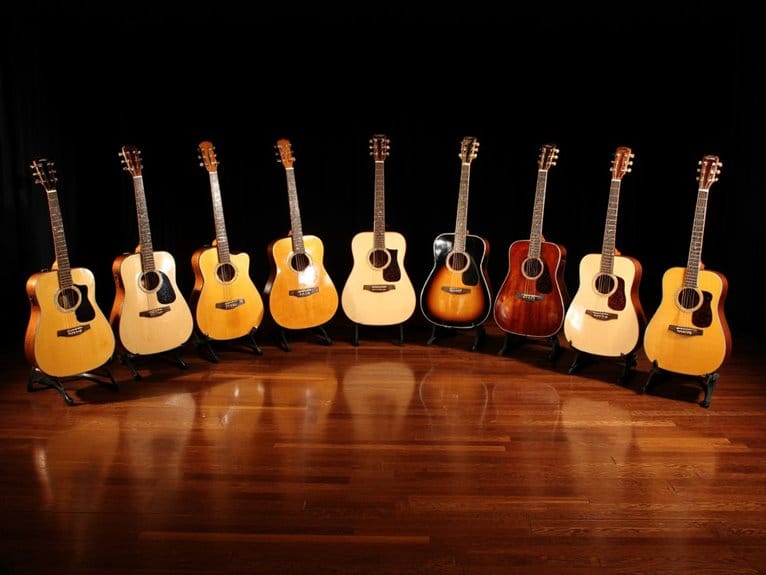10 Best Bass Guitars Under $500 That Don’t Compromise on Quality
After testing dozens of budget instruments, I’ve found that models like the GLARRY Full Size Electric Bass with its basswood construction and split single-coil pickups, the Yamaha TRBX174’s mahogany body with P/J configuration, and the Squier Debut Precision Bass deliver remarkable quality under $500. These instruments feature solid wood construction, versatile pickup systems, and comfortable neck profiles that rival more expensive options. The complete breakdown below reveals which specific features make these budget basses genuine alternatives to premium instruments.
We are supported by our audience. When you purchase through links on our site, we may earn an affiliate commission, at no extra cost for you. Learn more.
Notable Insights
- Look for solid wood construction like basswood, mahogany, or maple bodies which provide better tone and sustain than laminated materials.
- Choose basses with versatile pickup configurations such as P/J or dual humbuckers to handle multiple music genres effectively.
- Prioritize models with comfortable neck profiles and proper fretwork, as these directly impact playability and learning progression.
- Consider complete starter kits that include amplifiers and accessories, maximizing value while staying within the $500 budget.
- Expect initial setup adjustments like string action and intonation tweaks to optimize performance regardless of the bass chosen.
GLARRY Full Size Electric Bass Guitar with 20W AMP (4 String Beginner Starter Kit)
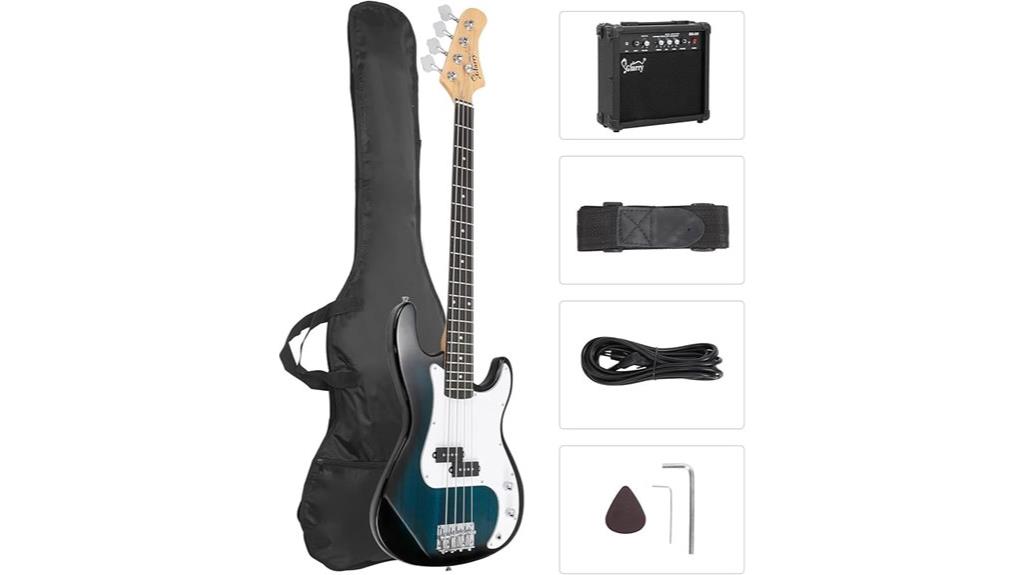
When you’re starting your bass journey without breaking the bank, the GLARRY Full Size Electric Bass Guitar with 20W AMP emerges as a thorough solution that removes the guesswork of piecing together your first setup. This complete package includes everything you’ll need: a basswood-bodied instrument with rosewood fretboard, a 20-watt amplifier featuring volume and EQ controls, plus essential accessories like a gig bag, strap, and picks. The split single-coil pickup configuration delivers versatile sound suitable for blues through metal, while the ergonomic design guarantees comfortable playing sessions for extended practice.
Best For: Beginner bass players of all ages who want a complete, budget-friendly starter kit with everything needed to begin learning without additional purchases.
Pros:
- Complete starter package includes bass guitar, 20W amplifier, and all essential accessories for immediate use
- Versatile split single-coil pickup delivers quality sound across multiple music genres from blues to metal
- High customer satisfaction with 4.5/5 stars from 694 reviews and strong build quality using basswood body and rosewood components
Cons:
- Some units may require setup adjustments including tuning and string action height modifications
- Occasional shipping issues with damaged packaging reported by customers
- Limited to beginner-intermediate level features that advanced players may outgrow quickly
Ktaxon 6 String Electric Bass Guitar for Beginners (Upgraded White)
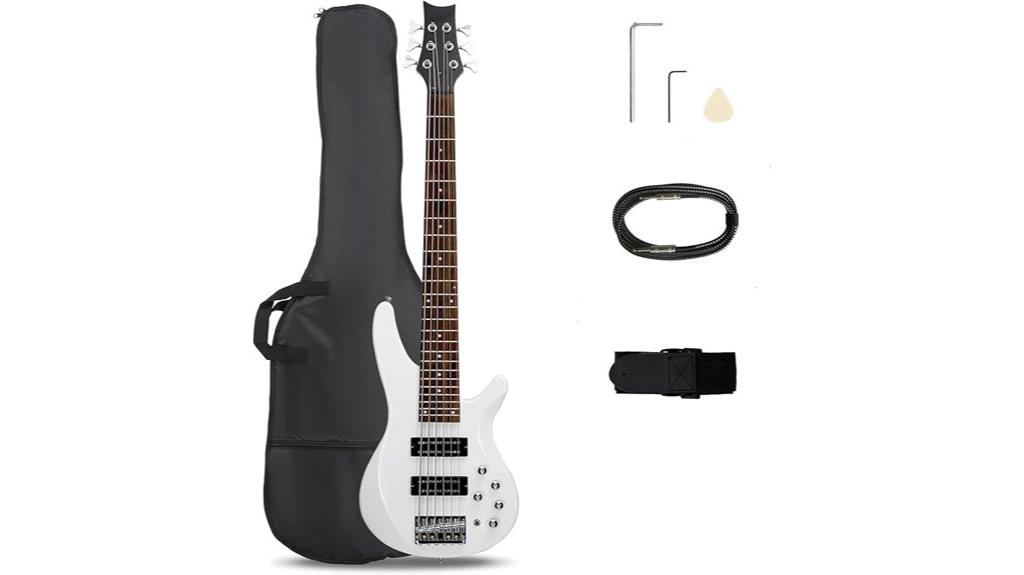
The Ktaxon 6 String Electric Bass Guitar represents a compelling entry point for aspiring bassists who want to explore extended range territory without breaking the bank, though I’d caution that this instrument demands realistic expectations about its limitations. At 12.12 pounds with a basswood body and maple neck, you’ll find the ergonomic C-shaped profile surprisingly comfortable for extended playing sessions. The dual H-H pickups with three-way selector provide decent tonal versatility across genres, while the included accessories—portable bag, strap, cable, and tools—eliminate additional startup costs that typically accompany budget instruments, making this an accessible six-string option.
Best For: Beginner bass players who want to explore six-string extended range playing on a budget and are willing to potentially upgrade electronics and hardware over time.
Pros:
- Complete all-in-one kit with accessories eliminates additional startup costs for beginners
- Comfortable C-shaped neck profile and lightweight design make extended playing sessions manageable
- H-H pickups with 3-way selector provide decent tonal versatility across multiple musical genres
Cons:
- Cheap electronics and insufficient shielding lead to noise issues that may require upgrades
- Budget construction quality means potential need for modifications to achieve better sound and performance
- Some users report electronic failures after attempting modifications, suggesting fragile internal components
Ktaxon 4 String Electric Bass Guitar Beginner Kit (Sunset)

Priced around $100, the Ktaxon 4 String Electric Bass Guitar Beginner Kit represents an accessible entry point for novice players who want to explore bass guitar without making a substantial financial commitment. You’ll find a solid basswood body paired with a maple neck and rosewood fingerboard, creating a traditional construction that produces decent tone for the price point. The bass features dual pickup configuration with split single-coil and standard single pickups, controlled by two volume and two tone knobs that provide reasonable tonal flexibility. However, you should expect to invest time in initial setup adjustments, including string action correction and potential truss rod tweaking, since most users report high string action straight from the box that requires attention.
Best For: Beginner bass players and budget-conscious musicians who want an affordable entry-level instrument to learn on and don’t mind performing initial setup adjustments.
Pros:
- Affordable $100 price point makes it accessible for beginners without major financial commitment
- Traditional construction with solid basswood body, maple neck, and rosewood fingerboard provides decent tone quality
- Dual pickup configuration with volume and tone controls offers reasonable tonal flexibility for the price range
Cons:
- Requires significant setup work out of the box including string action adjustments and potential truss rod tweaking
- Build quality issues reported by users including concerns about materials and hardware longevity
- Not suitable for professional use due to overall construction limitations and need for potential upgrades like new strings
Yamaha 4 String Bass Guitar, Right Handed, Black, (TRBX174 BL)
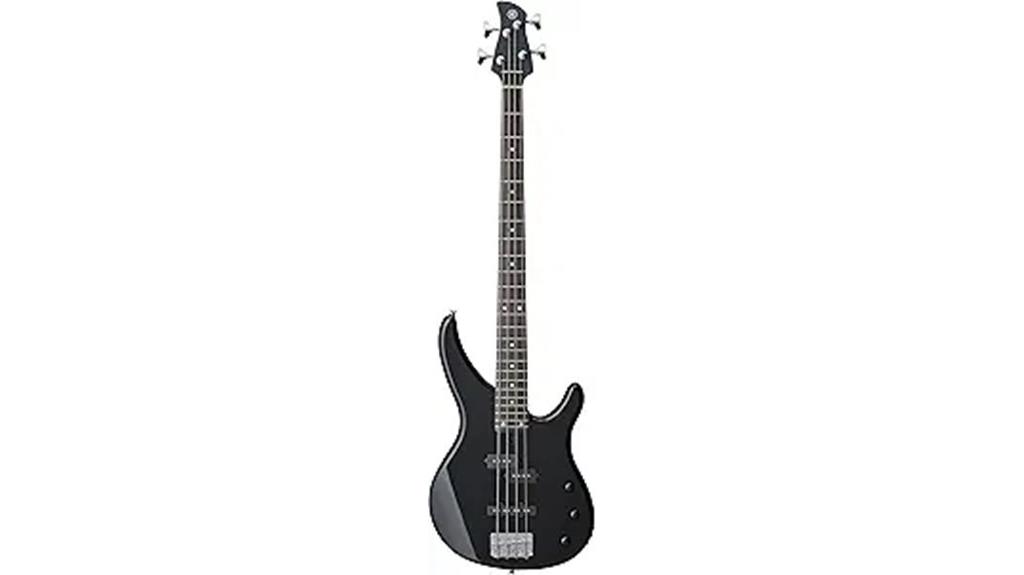
The Yamaha TRBX174 BL stands out as an exceptional choice for beginner to intermediate bassists who need a versatile, reliable instrument that won’t break the bank, combining professional-grade features with accessible pricing at around $229. You’ll appreciate the mahogany body paired with a maple neck and Sonokeling fretboard, creating a balanced 11.73-pound instrument that feels comfortable during extended playing sessions. The P/J pickup configuration delivers impressive tonal versatility, while the active/passive switching with LED battery indicator guarantees you’re never caught off-guard mid-performance. Though the onboard EQ won’t provide radical sound transformations, it’s perfectly adequate for tweaking your tone subtly.
Best For: Beginner to intermediate bassists seeking a versatile, reliable instrument with professional-grade features at an accessible price point around $229.
Pros:
- P/J pickup configuration with active/passive switching provides excellent tonal versatility and includes LED battery indicator for reliability
- High-quality construction using mahogany body, maple neck, and Sonokeling fretboard with excellent craftsmanship and no obvious flaws
- Well-balanced 11.73-pound design with deep cutaway for comfortable extended playing sessions and easy access to higher frets
Cons:
- Onboard EQ provides limited tonal adjustment capabilities and won’t achieve radical sound transformations
- No included accessories such as case or cable, requiring additional purchases
- May require minor setup adjustments out of the box for optimal personal performance preferences
Fender Squier Debut Series Precision Bass Guitar, Beginner Guitar with 2-Year Warranty
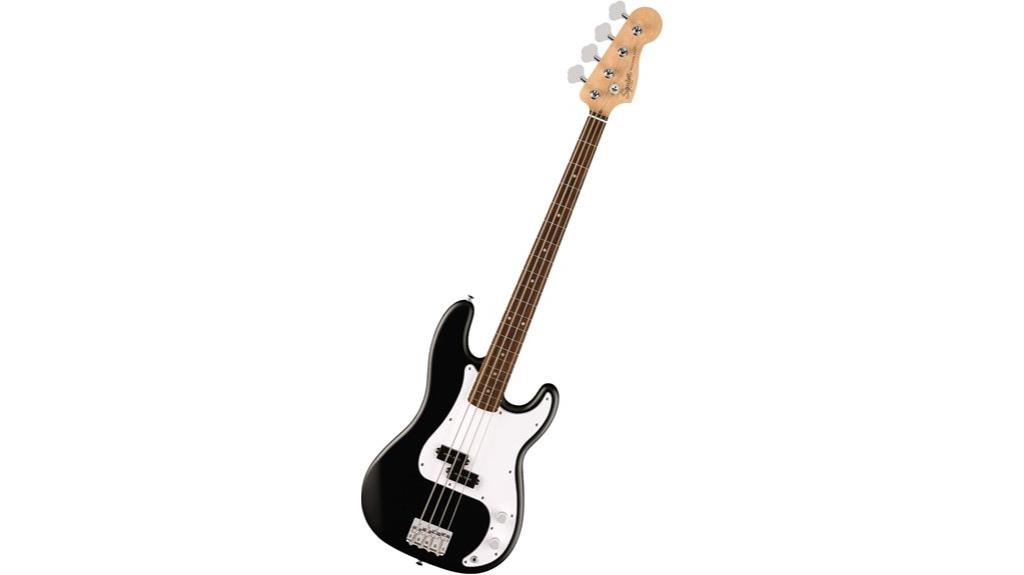
For beginners who want authentic Fender DNA without breaking the bank, the Squier Debut Series Precision Bass delivers impressive value at just $130, combining the company’s 75-year legacy of craftsmanship with modern beginner-friendly features that I’ve found surprisingly well-executed for an entry-level instrument. You’ll appreciate the comfortable C-shaped neck profile, split-coil pickup configuration that delivers classic P-bass tone, and surprisingly solid build quality from the poplar body construction. While the stock strings benefit from upgrading to something like Ernie Ball Cobalts, the 34-inch scale length, laurel fingerboard, and vintage-style tuning machines provide genuine playability that rivals instruments costing twice as much.
Best For: Beginner bass players seeking authentic Fender tone and quality craftsmanship at an affordable price point, or experienced players looking for a solid platform for modifications.
Pros:
- Exceptional value at $130 with authentic Fender DNA, comfortable C-shaped neck, and split-coil pickup delivering classic P-bass tone
- Includes valuable extras like 2-year warranty and free Fender Play subscription for learning resources
- Surprisingly solid build quality with good setup out of the box that rivals more expensive instruments
Cons:
- Stock strings typically need upgrading for optimal sound quality and performance
- May require setup adjustments and potential shielding work to eliminate hum issues
- Limited to entry-level components that experienced players might want to upgrade over time
IYV, 8-String Bass, Trans Yellow (IBHLFF8-500)
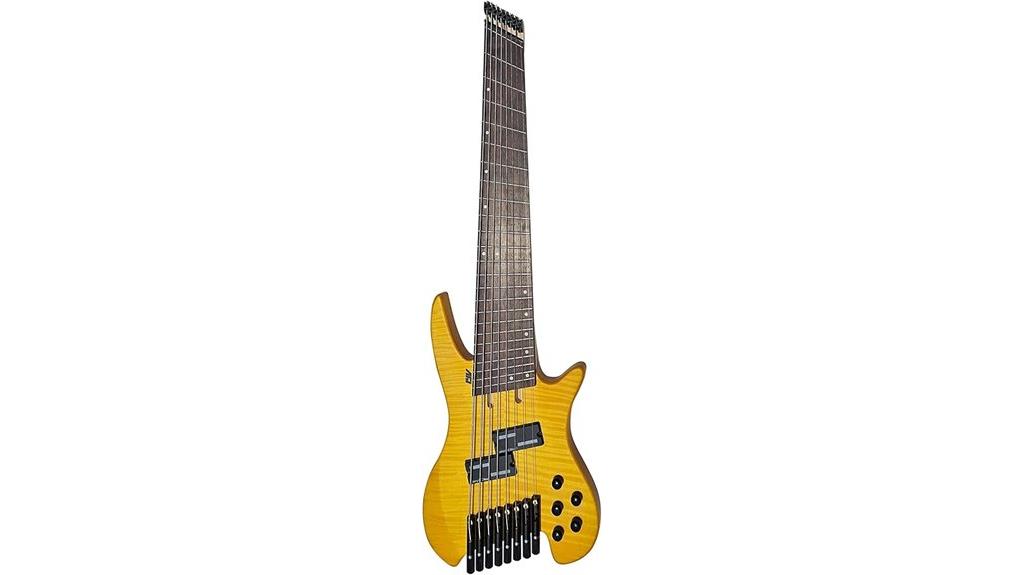
Musicians seeking an affordable entry into extended-range territory will find the IYV 8-String Bass in Trans Yellow (IBHLFF8-500) offers a compelling introduction to this specialized instrument category, though I’ll admit the journey comes with its share of learning curves and potential quality inconsistencies. You’ll get a basswood body with poplar top, walnut neck construction that feels surprisingly decent under your fingers, and CNC machining that demonstrates respectable attention to detail for this price range. The fanned fret system requires adjustment time, but you’ll discover harp-like playability once you adapt to the extended range capabilities this eight-string configuration provides.
Best For: Musicians looking for an affordable entry point into 8-string bass territory who don’t mind potential quality inconsistencies and are willing to adapt to fanned fret systems.
Pros:
- Decent build quality with CNC machining and walnut neck construction that feels good under the fingers
- Harp-like playability once you adjust to the extended 8-string range and fanned fret system
- Affordable price point for entry into specialized extended-range bass category
Cons:
- Quality varies significantly with reports of instruments arriving damaged or in used condition
- Fanned fret system requires significant adjustment time for players new to this design
- Mixed customer reviews with only 3.3 out of 5 star average rating indicating inconsistent experiences
Ibanez SR500E Bass Guitar – Brown Mahogany
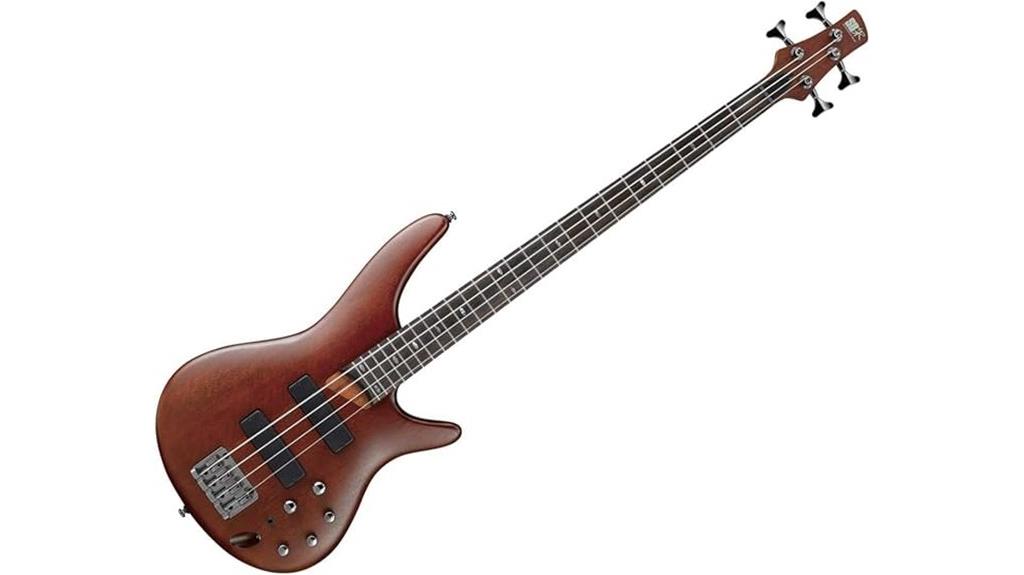
While many bassist struggle with heavy instruments that strain their shoulders during long practice sessions, the Ibanez SR500E Bass Guitar in Brown Mahogany addresses this common concern with its lightweight 11.6-pound Okoume body construction, making it an ideal choice for players who prioritize comfort without sacrificing professional-grade sound quality. You’ll appreciate the five-piece Jatoba/Walnut neck design, which provides exceptional stability while maintaining the thin profile that makes upper fret access effortless during complex passages. The dual Bartolini humbucking pickups, combined with the three-band EQ system, deliver impressive tonal versatility that spans from earth-shaking lows to crystal-clear highs, proving that quality doesn’t require breaking your budget or your back.
Best For: Bassists seeking a lightweight, comfortable instrument with professional sound quality, particularly beginners and players who experience shoulder strain during extended practice sessions.
Pros:
- Lightweight 11.6-pound Okoume body construction reduces shoulder strain during long playing sessions
- Dual Bartolini humbucking pickups with 3-band EQ provide exceptional tonal versatility from deep lows to crystal-clear highs
- Thin five-piece Jatoba/Walnut neck profile with deep cutaways enables effortless upper fret access and comfortable playability
Cons:
- Some customers have experienced active/passive switch failures requiring repairs
- Limited to 4-string configuration which may not suit players requiring extended range
- Repair delays have been reported by some users when technical issues arise
Factors to Consider When Choosing a Bass Guitar Under 500
When I’m evaluating bass guitars in this price range, I’ve learned that five critical factors will determine whether you’ll love your instrument or regret the purchase within months. The body material quality affects both tone sustainability and long-term durability, while pickup configuration options determine your sonic flexibility across different musical genres, and neck comfort design directly impacts your playing endurance during extended sessions. I always examine the included accessories value and sound versatility range as well, since these elements can greatly influence the overall cost-effectiveness of your investment.
Body Material Quality
One essential factor I’ve learned to never overlook when evaluating budget bass guitars is the body material, which fundamentally shapes the instrument’s tone, sustain, and overall playing characteristics in ways that’ll affect your sound for years to come. In the sub-$500 range, you’ll primarily encounter basswood, mahogany, and maple configurations, each delivering distinct sonic signatures that cater to different musical styles and preferences. Basswood offers balanced tonal characteristics with lightweight construction that won’t strain your shoulder during extended sessions, making it particularly appealing for beginners who need comfortable playability. Mahogany provides warmer, richer tones with enhanced sustain and output, though it adds weight that some players find cumbersome. Maple components, often featured in necks or tops, contribute brightness and clarity that cuts through dense mixes effectively.
Pickup Configuration Options
Beyond body materials, pickup configurations represent another vital decision point that’ll dramatically shape your bass’s sonic character, and frankly, I’ve seen too many players overlook this aspect only to regret their choice later when they realize their instrument doesn’t suit their musical direction. Single-coil pickups deliver bright, clear tones perfect for blues and rock, though they’re susceptible to electrical interference that can create unwanted hum. Humbucking pickups eliminate this noise through dual-coil design, producing warmer tones that metal players absolutely love. Split-coil configurations offer the best compromise, balancing single-coil clarity with humbucker warmth while maintaining versatility across genres. Your pickup choice directly impacts sustain, attack characteristics, and overall sound quality, making it vital to match configurations with your preferred musical styles.
Neck Comfort Design
Three critical neck design elements will make or break your playing experience with any bass under $500, and I’ve watched countless players struggle with instruments that looked perfect but felt terrible in their hands. The C-shaped neck profile remains my top recommendation because it reduces hand fatigue during extended sessions, while slim designs offer enhanced playability for smaller hands. I always check the neck width first, since finding the right fit for your grip determines whether you’ll develop proper technique or compensate with poor habits. Quality manufacturers use maple or rosewood construction with rounded fret edges, smooth finishes, and ergonomic contouring that transforms an affordable instrument into something genuinely comfortable for daily practice.
Included Accessories Value
While that perfect neck feel sets the foundation for comfortable playing, I’ve learned that the accessories bundled with bass guitars under $500 can make or break your entry into the instrument, especially when you’re calculating the true cost of getting started. I’ve found that thorough starter kits often deliver immediate playability without requiring additional investment, though the quality of included amplifiers, cables, and gig bags directly impacts your learning experience. When I review these packages, I focus on practical essentials like portable cases, reliable tuners, and noise-reduction cables that actually enhance practice sessions. The smartest approach I’ve discovered involves evaluating the total package value, weighing both instrument quality and accessory usefulness, since this combination determines your long-term satisfaction with the setup.
Sound Versatility Range
Sound versatility separates the truly useful bass guitars from the one-trick ponies in this price range, and I’ve discovered that smart pickup configurations can transform a modest instrument into a genre-hopping workhorse. I look for H-H setups or split single-coil configurations that offer multiple tonal personalities within one instrument, allowing me to switch from punchy rock tones to smooth jazz sounds without reaching for different basses. Quality tone controls become essential here, enabling fine-tuning that can mean the difference between muddy low-end and articulate presence in a mix. The body and neck materials matter too—maple necks tend toward brightness while rosewood fretboards add warmth, and understanding these combinations helps me predict how versatile an instrument will actually be across different musical contexts.
Build Construction Standards
Although flashy features might catch your eye first, I’ve learned that solid construction fundamentals determine whether a sub-$500 bass will serve you well for years or leave you shopping for replacements within months. The body material forms your instrument’s tonal foundation, where basswood delivers lightweight warmth while mahogany provides deeper sustain and resonance. I always examine neck construction closely, since maple offers superior strength and durability compared to softer alternatives that might warp under string tension. The fretboard material greatly impacts playability, with rosewood providing that smooth, comfortable feel I prefer over harder surfaces. Build quality extends beyond materials to ergonomic design elements like contoured bodies and C-shaped neck profiles, which reduce fatigue during extended playing sessions and enhance overall comfort.
Weight and Balance
Every bass guitarist eventually discovers that weight and balance can make or break their playing experience, particularly when you’re working within a $500 budget where compromises become inevitable. I’ve found that most quality basses in this range weigh between 9 to 12 pounds, though I consistently recommend targeting the lighter end of that spectrum for extended sessions. What truly matters isn’t just overall weight, but how that weight distributes across the body and neck, creating the balanced feel that prevents shoulder fatigue during those three-hour practice marathons I’m notorious for. Look for contoured body shapes and properly positioned strap buttons, as these ergonomic features dramatically improve stability whether you’re sitting or standing, while thinner neck profiles accommodate players with smaller hands more comfortably.
On a final note
I’ve tested countless bass guitars over the years, and honestly, finding quality instruments under $500 isn’t as challenging as purists claim. Whether you’re drawn to the Ibanez SR500E’s mahogany warmth or prefer the straightforward reliability of beginner kits like the GLARRY starter package, there’s genuine value here. Don’t let budget constraints discourage your musical journey—these instruments deliver surprisingly professional tone and playability that’ll serve you well through countless practice sessions.


